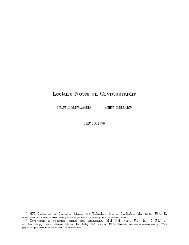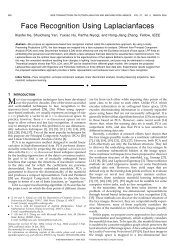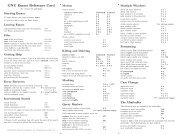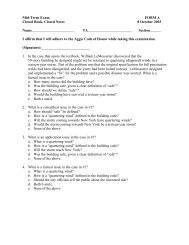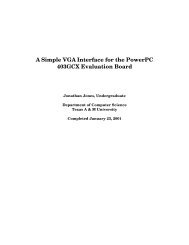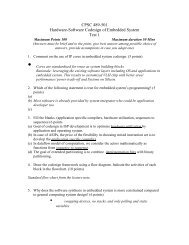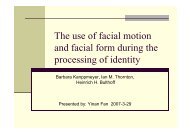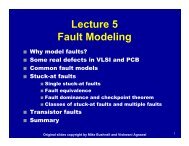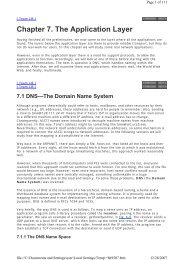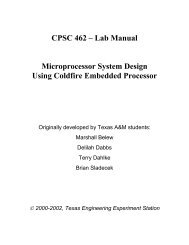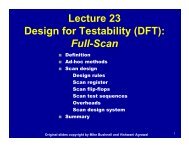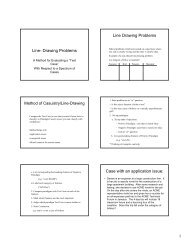Texturing - CS Course Webpages
Texturing - CS Course Webpages
Texturing - CS Course Webpages
Create successful ePaper yourself
Turn your PDF publications into a flip-book with our unique Google optimized e-Paper software.
<strong>Texturing</strong>
Texture Mapping<br />
• Geometry and lighting alone do not provide<br />
sufficient visible detail<br />
• Going from 3‐D to 2‐D<br />
“Paste” 2D image onto 3D surface<br />
• Surface appears much more complex than<br />
reality<br />
2/107
Texture Mapping
Texture Mapping<br />
4/107
Texture Mapping<br />
5/107
Texture Mapping<br />
6/107
Texture Mapping<br />
• Assume texture parameterized by u, v<br />
v<br />
1<br />
0<br />
0<br />
u<br />
1<br />
7/107
Texture Mapping<br />
• Any u, v coordinate maps to a point on the<br />
image<br />
v<br />
1<br />
0<br />
0<br />
u<br />
1<br />
8/107
Texture Mapping<br />
• Associate texture coordinates with each<br />
vertex on the surface<br />
v<br />
1<br />
0<br />
0<br />
u<br />
1<br />
9/107
Texture Mapping<br />
• During polygon drawing, lookup color from<br />
texture using interpolated texture coordinates<br />
v<br />
1<br />
0<br />
0<br />
u<br />
1<br />
10/107
<strong>Texturing</strong>: Geometry<br />
1. Compute object space location (x, y, z) from screen<br />
space location (i, j)<br />
2. Use projector function to obtain object surface coordinates<br />
(s, t ) from (x,y,z)<br />
(Usually we don’t care about the interior of the object)<br />
3. Corresponder function to find texel<br />
coordinates (u, v)<br />
11/107
Cylindrical Projector<br />
• Convert rectangular coordinates (x, y, z) to<br />
cylindrical (r, theta, phi), use only<br />
(theta, phi) to index texture image
Spherical projector<br />
• Convert rectangular coordinates (x, y, z) to<br />
spherical (theta, phi)<br />
Spherical projector
Sampling Textures<br />
1. Nearest neighbor<br />
Blocky results<br />
2.Bilinear Interpolation<br />
Smooth<br />
u,v
Nearest neighbor<br />
• Assume we can compose the previous steps<br />
(projector, corresponder, etc.) to define a<br />
transformation function M from integer screen<br />
coordinates (i, j) to real‐valued texture coordinates<br />
(s, t) such that M (i, j) = (s, t)<br />
• Now we just copy the texel at (round(s),<br />
round(t)) to the pixel at (i, j) and we’re done,<br />
right?
• Problem is that it can cause aliasing effects<br />
• Why? Because the round() function causes<br />
discontinuous switches in which texel is<br />
nearest and hence is the color drawn
Nearest Neighbor<br />
Blocky results
Bilinear Interpolation (BLI)<br />
Idea: Blend four texel values surrounding<br />
source, weighted by nearness<br />
Vertical blend<br />
Horizontal blend
Deal with Range<br />
• repeat: Start entire texture over<br />
• mirror: Flip copy of texture in each direction<br />
– Get continuity of pattern<br />
• clamp to border: Surround with border color
Other Uses of Texture Mapping<br />
• Environment Mapping<br />
• Bump/Normal Mapping<br />
• Displacement Mapping<br />
• ….<br />
• Any attribute of the surface position, normal,<br />
color, etc… can be placed in a texture<br />
20/107
Environment Mapping<br />
• Problem: To render pixel on mirrored surface<br />
correctly, we need to follow reflection of eye<br />
vector back to first intersection with another<br />
surface and get its color(especially for glass<br />
surface, metal surface...)<br />
• This is an expensive procedure with ray<br />
tracing<br />
• Idea: Approximate with texture mapping
Environment Mapping<br />
• Key idea: Render 360 degree view of<br />
environment from center of object with<br />
sphere or box as intermediate surface<br />
• Intersection of eye reflection vector with<br />
intermediate surface provides texture<br />
coordinates for reflection/environment<br />
mapping<br />
22/107
Environment Mapping<br />
23/107
Environment Mapping(Cube mapping)<br />
24/107
Environment Mapping<br />
25/107
Environment Mapping<br />
N<br />
26/107
Environment Mapping<br />
N<br />
27/107
Bump/Normal Mapping<br />
• Specify perturbation of normals by texture<br />
• Height map: store scalar “altitude”<br />
• Normal map: store nomals in RGB<br />
28/107
Bump/Normal Mapping Example<br />
30/107
Bump/Normal Mapping Example<br />
31/107
Displacement Mapping<br />
• Offset geometry in direction of normal<br />
• Encode offset inside texture<br />
• Used to actually change the geometry and<br />
provide more detail<br />
• Difficult/expensive to perform with current<br />
hardware<br />
32/107
Displacement Mapping Example<br />
33/107
Problems with Texture Mapping<br />
• Textures composed of separate pieces called<br />
“charts”<br />
• Boundaries don’t match<br />
• Sampling issues<br />
• ……<br />
34/107





